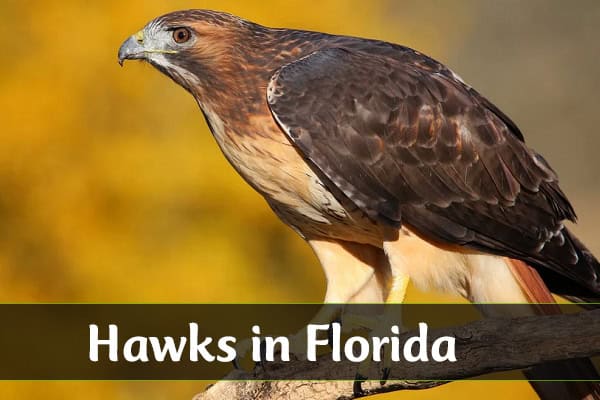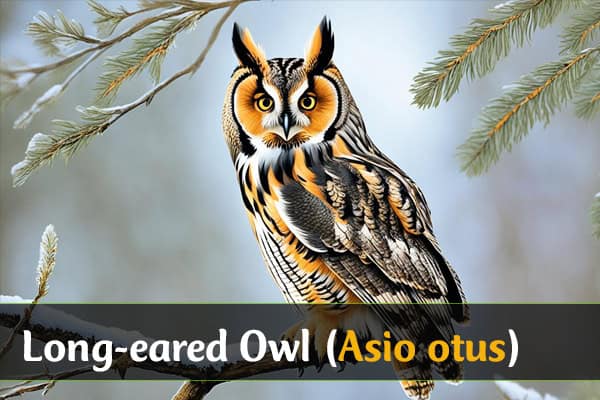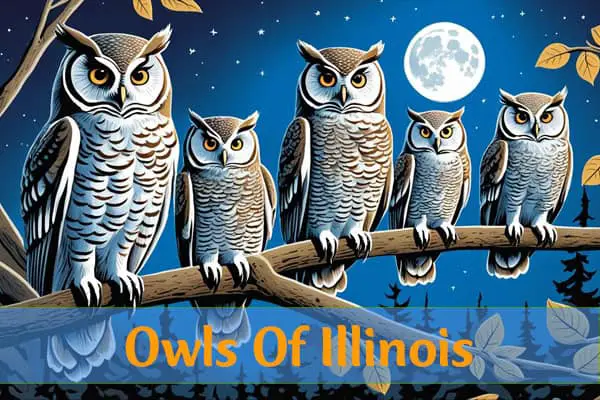8 Types Of Hawks in Florida (With Pictures)
Did you know the Hawks of Florida are home to many species? Each one has its own special traits and ways of living. From the famous Red-shouldered Hawk to the hard-to-spot Cooper’s Hawk, these birds of prey have caught the eye of nature lovers and birdwatchers. Let’s explore the fascinating world of Florida’s hawks and learn about the stories of these birds that fly through the Sunshine State.
Florida is known for its beautiful landscapes and rich wildlife. It’s a place where many birds of prey live and play a big role in keeping the ecosystem healthy. This article will take you on a journey to meet the different hawk species that call Florida home.
1. Red-shouldered Hawk
- Scientific name: Buteo lineatus
- Life span: 19 years
- Size: (43-61 cm)
- Weight: (486-774 g)
- Wingspan: (94-111 cm)
The red-shouldered hawk (Buteo lineatus) is Florida’s most common and well-known hawk. It has bright reddish-brown feathers and black-and-white patterns. This hawk is often seen in the state’s forests and even in suburban areas.
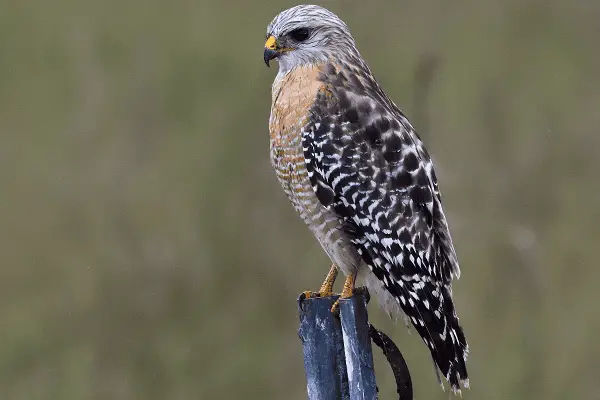
Habitat and Behavior
The red-shouldered hawk is loud and clear in Florida’s outdoors. It makes a loud, piercing call that fills the forest. These raptors in Florida hunt a wide variety of food, including small mammals, amphibians, and reptiles.
Nesting and Breeding
In the breeding season, red-shouldered hawks perform amazing aerial shows. They build big nests high up in tall trees. Here, they lay and care for their eggs.
Diet and Hunting Strategies
The red-shouldered hawk is an opportunistic hunter. It uses different hunting methods to catch its food. These hawks in Florida often wait patiently in a spot, then quickly grab small rodents, frogs, snakes, and other small animals.
Even though the red-shouldered hawk is not threatened globally, losing its habitat is a big worry in some parts of Florida. This makes protecting it very important for those who love wildlife and those who manage the land.
2. Northern Harrier
- Scientific name: Circus hudsonius
- Life span: 12 years
- Size: (46-50 cm)
- Weight: (300-750 g)
- Wingspan: (102-118 cm)
The Northern Harrier, also known as the “Gray Ghost,” is a fascinating bird that lives in Florida’s marshlands. It is the second most common hawk in Florida. This large hawk spends the winter here, coming from the Northern United States, Canada, and Alaska to breed.
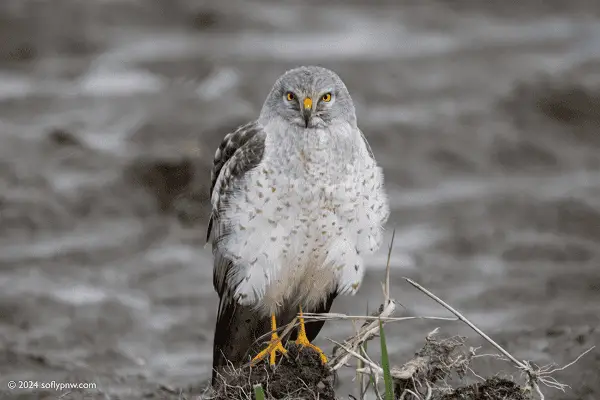
This bird is known for its owl-like face and grey color. The Northern Harrier (Circus hudsonius) is a special bird of prey. It loves open areas like moorlands, bogs, prairies, and marshes. Florida’s varied landscapes are perfect for it.
It’s interesting to know that a single male Northern Harrier mates with many females. Watching this bird glide low over the marshes is a sight to see. It hunts small mammals, birds, and amphibians.
Northern Harriers have great eyesight and hunt uniquely. They are key to Florida’s ecosystem. They help keep the food web balanced and add to the area’s biodiversity.
If you’re in the Everglades, central Florida’s prairies, or the panhandle’s coastal marshes, look for the “Gray Ghost.” It’s a true wonder of Florida’s raptors.
3. Red-Tailed Hawk
- Scientific name: Buteo jamaicensis
- Life span: 10-15 years
- Size: (50-65 cm)
- Weight: (900-1460 g)
- Wingspan: (114-133 cm)
The red-tailed hawk (Buteo jamaicensis) is a sight to behold in the Florida skies. It’s known for its bright red tail and huge wings, making it the largest hawk in Florida.

This hawk is amazing at flying high. It uses the wind to soar and find food. You can find it in many places, from wide open fields to city skies. It shows how well it can live in different places.
Breeding and Nesting
Red-tailed hawks build big nests in tall trees. They mate for life and show off in the sky to strengthen their bond during the breeding season.
Prey and Hunting Techniques
Red-tailed hawks have great eyesight and wait patiently for their prey. They hunt small mammals, birds, and reptiles. They use different ways to catch their food, from flying high to sitting in a good spot.
The red-tailed hawk is a symbol of Florida’s wildlife. It’s loved for its beautiful flying skills. As a common hawk in Florida, it’s important for the ecosystem. It helps keep the balance and is a symbol of nature’s beauty.
4. Cooper’s Hawk
- Scientific name: Accipiter cooperii
- Life span: 12 years
- Size: (37-39 cm)
- Weight: (220-410 g)
- Wingspan: (62-90 cm)
Hawks In Florida, the Cooper’s Hawk (Accipiter cooperii) is a standout. It’s known for its agility and stealth. This medium-sized raptor is great at hunting and can live in many places, from woods to cities.

Identification and Courtship Displays
Cooper’s Hawks have slate-gray feathers, red eyes, and a strong build. These traits help them fly fast and catch prey with precision. In spring, they show off with aerial tricks and sounds to find a mate and claim territory.
Nesting Habits
Cooper’s Hawks are smart nesters, choosing spots from forests to cities. They often use old nests high in trees. The female lays 3-6 white eggs, which she guards for a month. After about 4-5 weeks, the young ones can fly, but many don’t make it to adulthood.
The Cooper’s Hawk is amazing at hunting and living in different places. It’s a key part of Florida’s bird world. Learning about these birds helps us understand the balance in nature.
5. Sharp-Shinned Hawk
- Scientific name: Accipiter striatus
- Life span: 5 years
- Size: (24-34 cm)
- Weight: (87-218 g)
- Wingspan: (43-56 cm)
If you love birdwatching in Florida, you’ve probably seen the tiny sharp-shinned hawk (Accipiter striatus). It’s the smallest hawk in the Sunshine State. It looks a lot like the bigger Cooper’s Hawk, but it has its own unique features.
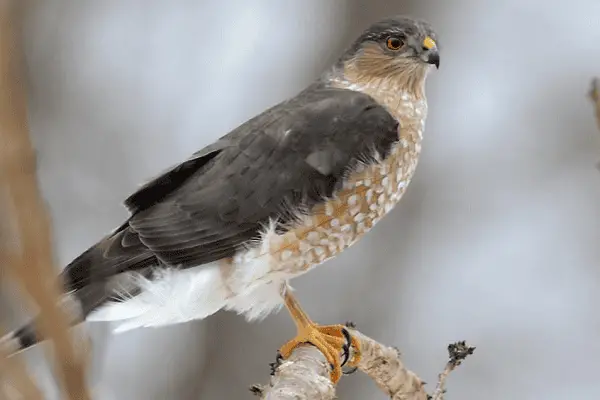
The sharp-shinned hawk visits Florida only in the winter. So, if you see an Accipiter in the summer, it’s probably a Cooper’s hawk. You can tell these hawks apart by their size. The sharp-shinned hawk is much smaller, measuring 9.4 to 13.4 inches long and weighing 3.1 to 7.7 ounces.
- Slender, square-tailed appearance
- Smaller, more delicate legs compared to the Cooper’s hawk
- Tendency to be found deeper within forested habitats
Even though the sharp-shinned hawk is small, it’s a great hunter. It uses its quick moves and speed to catch small birds in the bushes. Look out for these fast hawks when you’re exploring Florida’s bird world in the winter.
6. Short-Tailed Hawk
- Scientific name: Buteo brachyurus
- Life span: 20 years
- Size: (38–43)
- Weight: (362 –500 g)
- Wingspan: (83-103 cm)
The short-tailed hawk, known as Buteo brachyurus, is a fascinating bird found in Florida’s south. It’s known for its unique color changes, showing two main colors: dark and light.
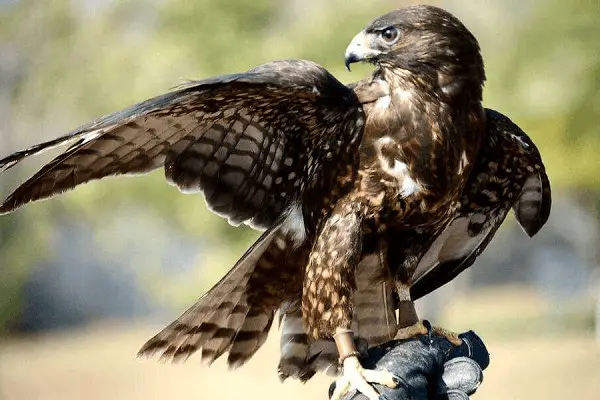
Distribution and Habitat
These hawks live all year in Florida’s southern parts, especially in the Everglades and the Florida Keys. In the breeding season, some move to central Florida. They like open woods and wetlands for hunting.
Hunting Behaviors
Short-tailed hawks in Folarida hunt in the air most of the day. They use a method called “kiting” to find small animals above the trees. Their wings stand out when they soar, making them easy to spot.
About 80% of these hawks in Florida have a dark color. The other 20% are light-colored. These colors stay the same for their whole life.
The short-tailed hawk is a special bird that makes Florida’s skies interesting. Its unique colors and hunting ways make it a great bird to watch and learn about.
7. Broad-Winged Hawk
- Scientific name: Buteo platypterus
- Life span: 12 years
- Size: (34-44 cm)
- Weight:(265-560 g)
- Wingspan: (81-100 cm)
The broad-winged hawk (Buteo platypterus) is a stunning raptor found in Florida’s skies. They make an amazing journey every year from North America to Central and South America. Florida is a key stop for them, where they rest and get ready for the next part of their trip.

Broad-winged hawks are easy to spot with their brown feathers, wide wings, and tail bands. In 2014, a record 5,756 of these hawks were seen in North Carolina. This event drew over 2,600 people, including scouts and nature lovers, who learned about these birds from Ranger Jesse Anderson.
The broad-winged hawk is not just a beautiful sight in the sky. It’s also vital to Florida’s ecosystems. These birds help show us how connected our natural world is.
Conservation Efforts and Challenges
Many hawk species in Florida are doing well, but they still face challenges. Habitat loss, human-wildlife conflicts, and past issues like DDT threaten them. Conservation efforts are underway to protect these hawks. They focus on preserving their homes, reducing conflicts with humans, and teaching people about these birds.
To solve these conflicts, different steps have been taken. All Florida raptors are protected by law, which helps keep them and their nests safe. If a nest is not active but needs to be removed, no permit is needed. But, if a nest is active with eggs or chicks, you need a permit from the U.S. Fish and Wildlife Service.
- Carrying an open umbrella or wearing a hard hat
- Erecting a shade structure
- Using an air horn
- Trimming branches during non-breeding seasons
- Eliminating attractants like unsecured garbage
In some cases, the U.S. Fish and Wildlife Service gives permits to remove birds, nests, and young. You can learn more about these permits on the USFWS website or by contacting USDA Wildlife Services.
Human activities also harm beach-nesting birds in Florida. Activities on the beach can hurt eggs and chicks. The Least Tern has adapted by nesting on rooftops, but this comes with its own dangers.
Audubon Florida’s Rooftop Program and volunteers help by putting chicks back on rooftops and adding fences to prevent falls. Volunteers are key in protecting coastal birds. They help reduce harm to birds, teach people, and make sure birds can nest safely.
Check Our Previous Articles:
Best Locations for Hawk Watching in Florida
Florida is a paradise for bird lovers and nature fans. It’s home to many hawk species. You can see these birds in places like the Everglades, with its forests and wetlands, or in open areas like prairies and marshes.
Looking for the best places to see hawks in Florida? Here are some top spots:
- St. Joseph Peninsula – This spot is amazing in the fall. You can see up to 300 birds in one day, including peregrine falcons.
- St. Vincent NWR – It’s great for hawk watching but you need a boat to get there. It’s a favorite among serious birdwatchers.
- Paynes Prairie Preserve – Near Gainesville, this is a December hotspot. You can see red-tailed hawks, marsh hawks, and kestrels along the La Chua Trail.
- Cape Florida SRA – In Miami, visit here in late September and early October. You might see sharp-shinned hawks, merlins, and peregrine falcons.
Florida has many great places for hawk-watching all year. With patience and a good eye, you can enjoy the beauty of these birds.
Wrapping Up…
The hawks of Florida are a key part of the state’s natural beauty. They include the common Red-Shouldered Hawk and the Broad-Winged Hawk, which migrate. These birds are crucial for keeping Florida’s ecosystem balanced.
We’ve seen how these birds adapt and survive in their homes. From the Red-Tailed Hawk’s graceful flight to the Cooper’s Hawk’s quick attacks, each species thrives in its own way. This shows the wide variety of hawks in Florida.
Learning about these raptors helps us protect them for the future. We can do this through conservation, saving their homes, and watching wildlife responsibly. Let’s remember to cherish and protect Florida’s hawks as we leave this journey behind. We must work to keep their skies safe for many years to come.

